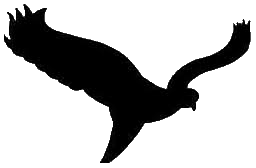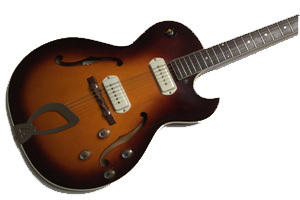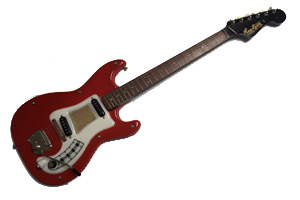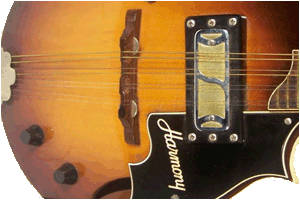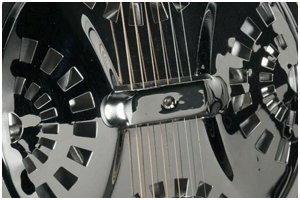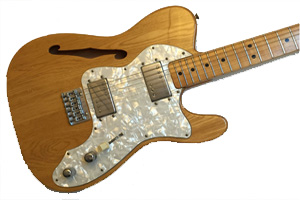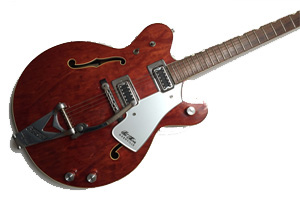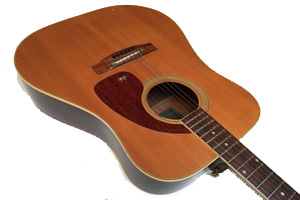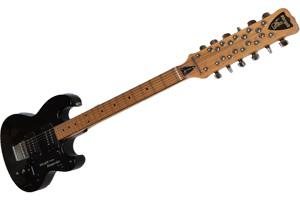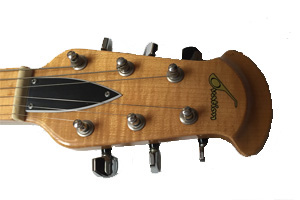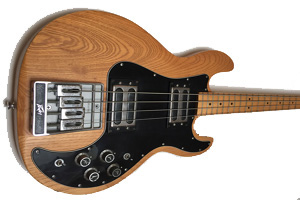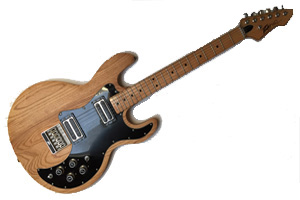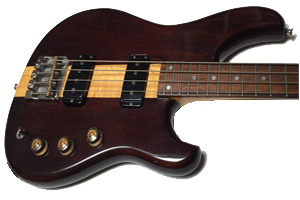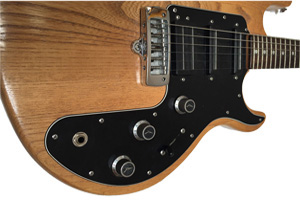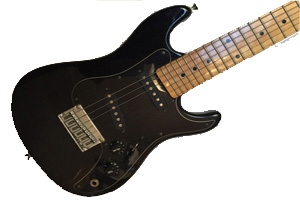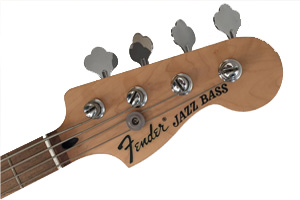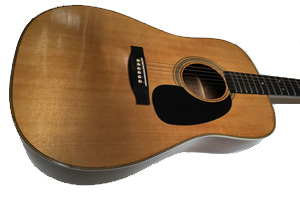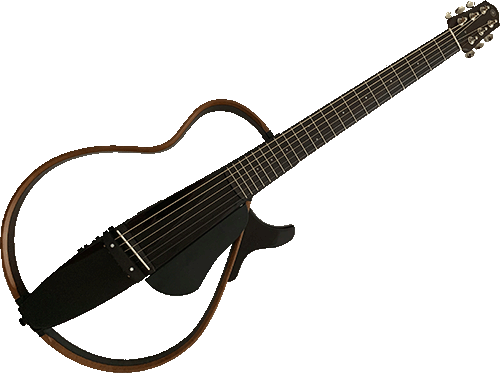|
|
|
|
 |
 |
Guild T-100 DP - 1959
This "Slim Jim" was built in late 1959. The "DP" addition stands for Dual Pickups, there was also a version with a single element at the neck. Only the pickguard was missing from my T-100, meanwhile I have found an original replacement in the USA. The pickups, this T-100 version has two, are of the type "Franz" (type P90s).
The cabinet is completely hollow with some risk of feedback as soon as amplified playing is performed. So there is no wood block inside as is the case with many Gibson ES.
A light instrument and comfortable to play on.
The guitar (more than 60 years old) and the case are in beautiful condition.
Hagstrom I - 1966
After refurbishing a "Hagstrom Model I" for someone, I thought it would be nice to have one myself.
The way in which the body has been finished is remarkable. The back is covered with a kind of vinyl and the front consists largely of a plate of hard plastic that is clearly visible screwed to the body.
There are 4 switches next to the volume knob. With the L and H sliders you can switch the neck and bridge element on or off. The tone slider puts a capacitor (0.04 uF) in parallel with the elements, resulting in less "high" passing to the amplifier. With mute, a fixed resistor (12 K-ohm) is connected in parallel, so that the volume is slightly squeezed. The cable can be plugged "horizontally" just above the volume knob.
The tilting tailpiece is known under the name "Tremar Vibrato". A simple system where a metal plate is screwed to the body, above which a movable other plate (with the strings attached) is coupled with a single spring.
The same model was also released under the brand name "Kent".
Guild T-100-DP - 1966
A Guild "Slim Jim" from 1966 with two so-called Mickey Mouse pickups (single coil). Maple (maple) body and mahogany neck.
With its light and only 2 inch deep body and also thin and short (24.75 inch) neck, the instrument is easy to handle.
The bridge was once replaced by a metal one, but the wooden version was easy to replace. Because the bridge is not glued, but is pressed onto the case via the strings, something like this could easily be repaired without leaving any trace.
Harmony H35 - 1969
No indeed this is not a guitar but an electric mandolin built in September 1969.
Original and therefore still equipped with a "DeArmond gold Foil" pickup. In Harmony's leaflet it was called "Golden Tone pickup".
The brand name "Harmony" is engraved in the plastic plate that covers the head. Its shape fits well with the "batwing" pickguard which is also engraved.
A similar Harmony H35 was also played by Led Zeppelin's John Paul Jones during an acoustic band tour in 1975.
Dobro 60 DN - 1976
The date inside the "case" refers to December 1975, but the serial number indicates that the instrument left the factory in 1976.
This Dobro has a "round" neck and can simply be used as a guitar. Often these models have a flat "square" neck and can be used with a slide "on lap".
The brand got its name from the DOpyera BROthers who are the founders of the company. Actually incorrectly, similar resonator guitars from other brands are also sometimes referred to as Dobro.
Ibanez 2384 - 1976
Japanese imitation of a Telecaster Thinline with double humbuckers (2384-60).
These were produced from 1974 to 1976, this is from March of that last year. The elements are from 1975 (neck) and 1976 (bridge).
The 3-position switch had to be replaced, just like the 2 buttons. Then it turned out to be a surprisingly good instrument in terms of playability and sound.
Ash body.
Gretsch 7660 - 1977
A dark red Gretsch from February 1977. The 7660 was the successor of the 6120 model from 1972. From 1990 it appeared again as 6120 "reisue".
When I got this "Nashville Chet Atkins" in my possession, the guitar was difficult to play. The bridge was very high and lowering was not an option because the bridge shifted easily and the sound was no longer good. The seller had already pointed this out to me. The advantage may have been that the guitar was hardly used and is still in good condition.
After slightly lowering the original Bigsby, everything was fine again and it became an exceptionally pleasant to play and good sounding Gretsch.
A guitar "made in USA" with some German and English blood.
Takeharu WK-150 - 1977
My first "real" acoustic guitar. Bought new (at Euromusic in Apeldoorn in The Netherlands, it must have been around 1977). The Takeharu is, as the name suggests, of Japanese manufacture. I didn't really know the brand at the time, but the thing was affordable for me at the time. Over the years, after I can better estimate the quality of the build and the character of the sound, it turns out to be a good guitar. Solid spruce top, rosewood back and sides.
The neck does have a fairly strong D / V shape, which you may have to get used to.
Nowadays you have Google and I have now learned the following: Takeharu Guitars were a brand of the Kiso Suzuki Violin company made between 1973 and 1979. The Takeharu name comes from Yamamoto Takeharu (may 22, 1925) a guitar player and composer who played a large part in the spread of the popularity of guitar music in Japan. The instruments were stamped with either 1-star, 2-stars, or 3-stars inlaid on the headstock, with 3-stars representing the very best, but all models are exceptionally good and are becoming increasingly collectable.
Shergold Custom Masquerader 12 - 1978
A "handcrafted in London" 12-string guitar from the British brand Shergold. The neck is very thin and pleasantly playable for a 12-string guitar (and actually when it would be a 6-string version).
Two humbucker pickups, each of which can be switched as single or double coils. In addition, an option to put them in opposite phase, different combinations possible.
The body has been repainted (black instead of the original sunburst color) and a metal bracket has been placed on the head afterwards, which presses the strings down into the nut.
From 1982, only guitars were built by order, using parts that were still available. Shergold quit in 1992 when one of the founders died
You sometimes come across them second-hand and they are quite worthwhile for those looking for a good guitar. You must always explain to everyone what you have in your hands. For more info see: http://www.shergold.co.uk.
In early 2017, the brand was revived and instruments are available again under the same name https://www.shergoldguitars.com.
These are now built in Indonesia and eventually tuned in England to give them a bit of a "UK character".
Ovation Viper - 1978
Ovation is best known for the acoustic guitars with the convex plastic body. This Viper 1271 is an electrical product and is made of wood. The sound of the elements is somewhat similar to that of a Telecaster.
Such Vipers were built from the mid-1970s to the early 1980s. After that, an acoustic guitar was released, which was also given the name Viper.
Unfortunately a crack in the pickguard at the connection for the plug.
Ibanez MC-300 DS - 1979
The neck, which is made up of five pieces of wood, runs completely through the body. DS stands for "dark-brown stain", there was also an NT "natural stain" version.
The elements are as far as I know of the type "Super 88".
On the top wing a switch to select the desired element. At the bottom of the body tone controls per element and one for the master volume. With 2 small switches (tri-sound) you can choose per element: single coil, out of phase or as a humbucker.
This MC-300 is also equipped with a 6-position Varitone switch, something that you will not find on every MC-300. In fact, it is a switch that allows you to select from a few different tonal characteristics, something that you can also find on the old Gibson ES-345 (unfortunately it was often "turned off" afterwards, in the assumption to get a better sound) .
The instrument looks like it is used sporadically and is in near mint condition.
According to the serial number it is from September 1979 ..
Peavey T40 - 1979
A 1979 Peavey bass guitar.
Actually a universal and fine bass, but it may not have the "right" image to be seen by bass players for the serious work. However, if you take the trouble to experiment with the different positions of the switches and buttons, you will discover that there are certainly different useful sounds. See also, for example, this link.
A heavy instrument, such as more guitars and basses from the 2nd half of the 1970s. . .
Peavey T60 - 1979
The T-60 is one of the first guitars manufactured largely by a computer controlled machine. Undervalued and therefore still offered for relatively low prices.
You need to know the tone controls. With the button on 10 the element functions as "single coils" and towards position 7 the second coil is added and it becomes a humbucker. Turning even further from 7 toward position 0 has the effect of a conventional tone control.
My T60 is in perfect condition and it is still the early version with the designation "patent applied for" mentioned on the head.
Ibanez Musician Bass MC-824 - 1980
A neck that extends fully into the body. At the back of the neck it can be seen that it consists of 3 wide parts with narrow dark (walnut) strips in between.
In the original folder they describe the wood used as mahogany combined with the lighter colored ash.
I think this version is officially called MC-824DS, where DS stands for "dark-stain".
In addition to this "passive" bass, there is also an active MC-924 version, which is easy to recognize by 3 extra equalizer buttons on the front and a space for a 9-volt battery in the back of the body.
Peavey T27 Limited edition - 1983
The limited edition is the same as a "normal" T27 but has modified electronics and a "rosewood" neck (or a rosewood fingerboard).
The T27 is equipped with two single coil pickups and one humbucker. A quirky circuit was chosen, see also : Peavey T27 operating guide.
Samick Mini - 1989
Nice mini guitar built using standard parts such as: the pickups, the controls and the machine heads. However, the body is a lot smaller and also thinner. This was probably a way for the manufacturer to get rid of the scraps of wood. The neck has a common width, but is of course a lot shorter.
The tuning is A-D-G-C-E-A, as if you are playing on a guitar with a capo in fifth position. Two elements, a 3-position switch and controls for volume and tone. Approximate year of construction.
May be missing in every collection.
Signature Jazz bass - 1990
I had once bought a Jazz bass body (according to the seller of the decayed Canadian brand "Signature", but that is actually impossible to trace) and mounted an aftermarket Fender Jazz Bass neck on it.
The strings should actually run through the body, but I chose another bridge (Shaller). Sound with a lot of power and easy to play. Collective value? No not really . . .
Own construction D28 - 2008
A self-built acoustic guitar that looks a bit like a Martin D28.
Rosewood back and sides and a spruce top. Mahogany neck with an ebony fingerboard. Waverly tuners. Mother of pearl inlay in the head. The nut is made of bone.
The most difficult job turned out to be the bindings of the sound box. For some reason I only had the desired result when using a third type of glue.
Martin 000-15 - 2008
A mahogany guitar that sounds so good that I couldn't leave it in the store.
Equipped with an "L.R. Baggs Anthem Pickup system", this Martin also behaves very well. This system consists of a piezo element mounted directly under the bridge in combination with a condenser microphone that is also located inside the cabinet. The mix between the two sources can be determined with a controller. A 9-volt battery provides the necessary power.
The rosette was actually more of a kind of sticker (and that with a Martin) and it has since disappeared spontaneously. Maybe better like that.
My daughter's favorite acoustic guitar when she is in the Netherlands and performing.
Yamaha ERB070 - 2008
 Inexpensive 4-string "beginner" bass from Yamaha.
Inexpensive 4-string "beginner" bass from Yamaha.
There is nothing else to say about it.
Yamaha SLG200S - 2019
A concept that I saw something in. An "acoustic" guitar (although there is no speaker) that can be connected to an amplifier. Compact and lightweight and, partly because the top "wing" can be dismantled, easy to carry. Built-in electronics and a design that appeals to me, but the latter is of course personal.
Since I had never owned such a copy before, I was very curious what my findings would be. New out of the box, the instrument appears to be reasonably to well adjusted. If you look more critically, you will come across some points that you may want to adjust first. The neck plays quite stiff and the frets on the sides are a bit too sharp for me. Some frets also had to go a bit further in the fingerboard because they were slightly higher than the rest. The strings in the nut have been lowered and the bridge on the bridge has been lowered. The neck was perfectly straight and was therefore slightly more hollow. Because the choice of strings is decisive, the strings are immediately replaced.
The lack of a sound box allows you to play on it without the risk of disturbing others. You can still hear the sound without amplification, otherwise you have the option of plugging "earphones" or headphones directly into the guitar. Then you can immediately enjoy the built-in effects such as reverb and chorus. Naturally, there are also controls for volume and tone and the built-in tuner is handy.
Two AA penlights provide the necessary power and there is also the possibility to connect a mains adapter for the power supply. Funny that a connection for an MP3 player has been thought of so that you can mix the sound with your guitar playing. Provided that some adjustment work in advance, quite a recommendation is my conclusion.
Martin OOO-15M - 2022
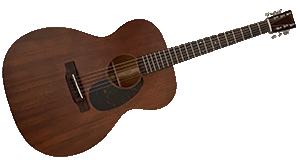 After I gave my 2008 Martin to my daughter, it turned out that I missed it (more than I could ever imagine). An all-mahogany OOO-15 not only looks great, but plays great and has a tone that invites you to play endlessly. I hadn't managed to find a 2nd hand copy yet so I decided to buy a new one.
After I gave my 2008 Martin to my daughter, it turned out that I missed it (more than I could ever imagine). An all-mahogany OOO-15 not only looks great, but plays great and has a tone that invites you to play endlessly. I hadn't managed to find a 2nd hand copy yet so I decided to buy a new one.
